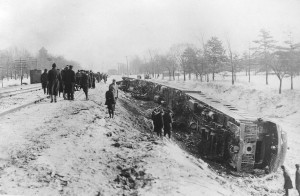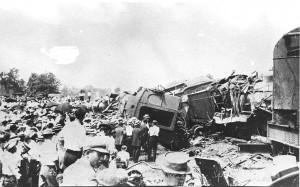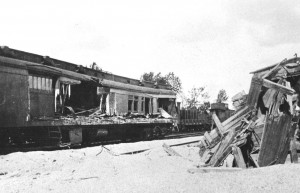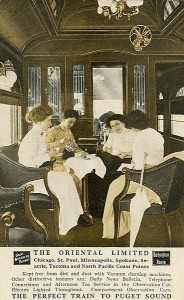Between 1909 and 1915, there were three serious train wrecks in Western Springs. And, following each, local residents were instrumental in aiding the victims.

1910 Train Wreck
In 1909, the Oriental Limited from Seattle to Chicago was one of the nation’s most luxurious trains. As shown in the first photo, the trains were “electric lighted throughout”, were kept spotless by “vacuum cleaning machines”, and served afternoon tea. But, on the snow-covered morning of December 18, the eastbound train to Chicago was running seven hours late. Some speculated that the train was operating too fast, trying to make up time.
At 4 a.m., just as the train was passing what is now Spring Rock Park, a broken rail sent the train careening off the tracks, tearing up more than 200 feet of the roadbed and landing on its side. The train included a buffet car and two sleeper cars, which were carrying a total of 50 passengers, many of whom were still asleep in their berths. Miraculously, no one was killed, but 31 passengers were injured. In the second photo, you can see the train lying on the south side of the tracks with the Western Springs water tower in the distance on the left.

1912 Train Wreck
According to the Western Springs Historical Society archives, George Bohnoff, who was a paper delivery boy at the time, recalled that morning in his later years. Waiting in the bitter cold, predawn hours for a train carrying his newspapers from Downers Grove, he suddenly heard a terrific crash. He ran west past Woodland Avenue, where he saw the train lying on its side. Another resident, Albert Erickson, recalled some of the injured being brought to his home, where his mother tore up bedsheets to use as bandages. While the injured were transported to area hospitals that morning, it took several days to remove the wreckage.

1915 Train Wreck
Afterward, life for the village’s 905 residents returned to normal. But, less than three years later, on Sunday, July 14, 1912, an even worse accident occurred.
Sometime before 6:30 a.m., the Overland Express train from Denver was approaching Western Springs. The train consisted of a steam engine, three baggage cars, two coaches, one chair car, and five sleepers. While the railroad used both telephone communications between towns and visual signals to separate trains, on this particular morning there was a heavy fog. As a result, when the train stopped in Western Springs to investigate a possible mechanical problem, the train’s flagman walked west to signal any approaching train that the track was not clear. But, this proved to be too little and too late.
Due to what was later determined to be “miscommunication” between the Western Springs and Hinsdale railroad stations, a train known as the Fast Mail was allowed to pass through Hinsdale toward Western Springs at high speed. While not carrying any passengers, the train consisted of a steam engine, four mail cars and three baggage cars. According to the official inquiry, the heavy fog prevented the engineer from seeing the flagman or signals. Only at the last minute was he able to see the other train ahead and begin emergency braking on his 50+ mile per hour train.

Oriental Limited Observation Car, Tea Time
At 6:36 a.m., the mail train struck the Overland Express’s rear sleeping car, slicing it open “like a knife”, and completely demolishing it. The second car was derailed and partly overturned. The accident occurred approximately 150 yards east of Wolf Road. In total, 11 passengers and 2 railroad employees were killed, with injuries to 26 other passengers and 2 railroad employees.
As was true just two and a half years earlier, the village’s townspeople threw open their homes to aid the injured. All area doctors were summoned to the scene. Nearby homes and Keil’s Drug Store, today The Competitive Foot, were used as temporary hospitals, as well as places where survivors could contact relatives by phone. The Western Springs Fire Department removed many of the injured from the wreckage, and also retrieved mail bags from the two trains. The LaGrange Fire Department assisted by laying some 1,200 feet of fire hose to reach the scene. While the Western Springs fire department had its chemical hose cart on site, it was used sparingly due to the second train’s fireman being pinned beneath the wreckage.
Following the crash, the village returned to some state of normalcy. But, on September 20, 1915, a third accident occurred at virtually the same location.
This time, a freight train was on the south track heading east, while the Missouri Limited passenger train was on the center track heading west. As the two trains were passing each other headed in the opposite direction, one of the freight cars derailed, sending several more freight cars directly into the path of the engine pulling the passenger train. Traveling at an estimated 50 miles per hour, the passenger train hit the freight cars and derailed. While the passenger train was badly damaged, the derailed wooden freight cars were virtually destroyed by the impact.
The passenger train’s fireman was badly burned and later died at a hospital. However, since the Missouri Limited had both a steel mail car and an express car directly behind the steam engine, these absorbed much of the impact, somewhat protecting the passenger cars behind them. However, 23 passengers were still injured, many of whom sustained broken arms and legs.
According to a newspaper report from that day, “The residents of Western Springs responded most nobly and were quickly on the ground with bandages and gave what assistance they could until doctors arrived.” The remaining cars of the train were also connected to the village’s lighting system, thereby allowing doctors to more easily provide first aid. The fire departments of Western Springs and La Grange performed rescues, and also prevented a fire in the steam engine from spreading.
While pedestrian and grade crossing accidents have occurred since then, there have been no subsequent train wrecks in the village. Modern techniques for inspecting and replacing rails, plus much more sophisticated train signals and controls, have greatly improved rail safety. One need only reflect on these past accidents to appreciate the modern rail system we have today.
